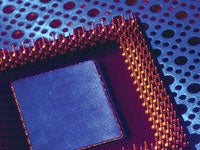 |
Just how many “brains” does your personal computer need, anyway?
Not that buying a PC was ever as easy as, say, buying a toaster or an electric toothbrush, but the companies that make the electronic brains, or microprocessors, for PCs today have managed to make it even more complicated.
It used to be that Intel (NASDAQ: INTC), the biggest maker of chips that are the central computing engines of PCs, and rival Advanced Micro Devices (NYSE: AMD) would sell to PC makers similar versions of the same CPUs.
As far as consumers were concerned, Intel made Pentium chips and AMD made Athlon chips. Yet the situation has been far more complicated than that for a while now, and in the last few years, the choices facing consumers when they go to buy a PC have mushroomed.
With computer games becoming more mainstream and more people making and editing digital pictures and home movies, PCs now boast microprocessors with two “brains,” four “brains,” and soon, even more.
Intel, for instance, sells dual-core Pentium and Core processors, as well as quad-core chips for more demanding PC uses such as editing high-definition video of a family vacation or intensive games. AMD has a similar array of offerings.
But does the average Joe really need such souped-up chips?
“It’s an interesting question,” said Tim Bajarin, a long-time technology analyst and consultant with Creative Strategies. “If the basic issue is productivity like Web browsing, word processing and e-mail, you don’t need all that much. A dual-core processor is good enough.”
If I only had two brains…
“When you actually break it down, the base processors like 1.3 to 1.6GHz are more than enough,” Bajarin said, noting the basics are fine if you’re watching a YouTube video or a network TV show online, though the video quality won’t be anything like a regular TV, let alone high-definition TV.
AMD’s Web site invites visitors to compare its different microprocessor offerings: The AMD Phenom, Athlon and Turion chips. All of those come in varying clock speeds, or how fast a chip will perform the instructions or tasks it’s given.
On Intel’s Web site, once you navigate past seemingly simple introductory pages, you find 11 different basic products from which to choose, including the Core 2 Extreme, Core 2 with Viiv technology, Core 2 Quad, Core 2 Duo, Pentium dual-core, and Celeron processor. And those are just the desktop versions.
“The reason we got into a multi-core world was not because we needed more and more cores to do the computing work, but because Intel and AMD had run out of room to increase the frequency on the processor,” said Endpoint Technologies analyst Roger Kay.
Before Intel and AMD started selling chips with two or more cores, they had simply cranked up how quickly the transistors — the tiny switches that make up semiconductors — could turn on and off to process computing tasks.
But as chips ran at higher and higher frequencies, the processors began using too much power and generating too much heat inside cramped desktop and notebook PCs.
So now consumers choose from different dual- and quad-core offerings (AMD even sells a processor that has three brains). And prices for PCs from brand-name companies now range from $300 to $4,000 and more for a high-end extreme gaming PC.
With that sort of variety, PC makers like Dell (NASDAQ: DELL) and Hewlett-Packard (NYSE: HPQ) and the processor makers have responded by placing all the different types and speeds of PCs into three basic categories that you can think of as every day computing, some performance and lots and lots of performance.
“What you’ve got is basically good, better and best, but the PC makers don’t like you to call it that,” Kay said.
For those who want to surf the Web, watch online videos, store music and photos, watch movies, do word processing and e-mail and keep a home budget, a PC with a dual-core processor from either AMD or Intel should do the trick, analysts said.
But consumers should consider spending more for a quad-core system if they plan to edit HD video you’ve taken with their HD camcorder, have a budding musician in the family who likes to mix digital music tracks, or are into the latest hard-core video games that are especially taxing on processors and video graphics chips.
“This particular question goes back almost to the beginning of computing: You basically try to buy the most computing power you can afford, with the understanding that you can expect applications will continue to get better,” Bajarin said.


